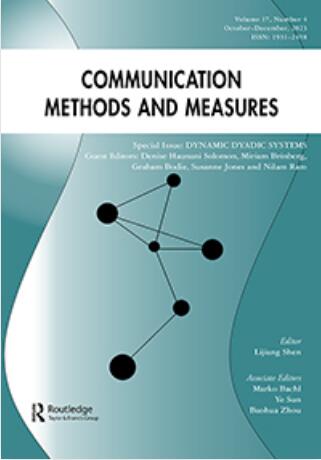A Dynamic Dyadic Systems Perspective on Communication of Real-Time Support Between Graduate Women in STEM and Their Mentor
IF 3.7
1区 文学
Q1 COMMUNICATION
引用次数: 1
Abstract
ABSTRACT Women of Color (WoC) in science, technology, engineering, and math (STEM) leave doctoral programs at disproportionately high rates. Supportive mentorship is key to increasing belonging and rates of retention, yet little is known about how conversations between mentees and their mentors on academic and personal stress topics unfold in real-time. Applying the lens of Social Cognitive Career Theory to communication dynamics between mentees and mentors, the present study utilized a dynamic dyadic systems (DDS) perspective to examine observationally coded data from six mentee-mentor dyads. First, hierarchical clustering analysis was applied to identify speaking turn types. Then, sequence analysis was used to identify common multi-turn patterns or conversation motifs (CM). Results showed five predominant CMs: (CM1) support provision through listening; (CM2) focus on mentor’s experience; (CM3) support provision through advice; (CM4) mentee’s making a bid for support; and (CM5) mentor dominated conversations. This study demonstrates methods for identifying potentially meaningful patterns of support in stress conversations between mentees and mentors. The application of such methods with larger samples may aid in understanding ways to increase retention among WoC in STEM through mentor support provision.动态双元系统视角下的STEM专业女性毕业生与导师之间实时支持交流
本文章由计算机程序翻译,如有差异,请以英文原文为准。
求助全文
约1分钟内获得全文
求助全文
来源期刊

Communication Methods and Measures
COMMUNICATION-
CiteScore
21.10
自引率
1.80%
发文量
9
期刊介绍:
Communication Methods and Measures aims to achieve several goals in the field of communication research. Firstly, it aims to bring attention to and showcase developments in both qualitative and quantitative research methodologies to communication scholars. This journal serves as a platform for researchers across the field to discuss and disseminate methodological tools and approaches.
Additionally, Communication Methods and Measures seeks to improve research design and analysis practices by offering suggestions for improvement. It aims to introduce new methods of measurement that are valuable to communication scientists or enhance existing methods. The journal encourages submissions that focus on methods for enhancing research design and theory testing, employing both quantitative and qualitative approaches.
Furthermore, the journal is open to articles devoted to exploring the epistemological aspects relevant to communication research methodologies. It welcomes well-written manuscripts that demonstrate the use of methods and articles that highlight the advantages of lesser-known or newer methods over those traditionally used in communication.
In summary, Communication Methods and Measures strives to advance the field of communication research by showcasing and discussing innovative methodologies, improving research practices, and introducing new measurement methods.
 求助内容:
求助内容: 应助结果提醒方式:
应助结果提醒方式:


